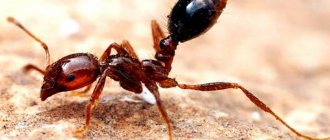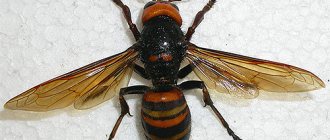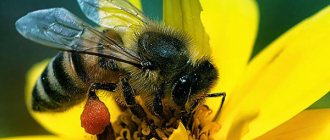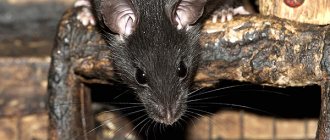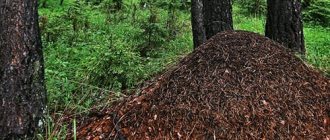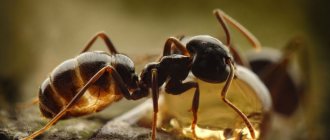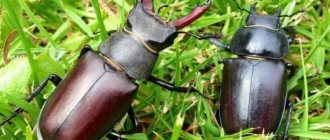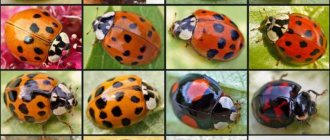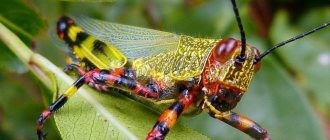Ants: general characteristics
Ants are insects that live in almost all corners of our planet, with the exception of Greenland and Antarctica, as well as some oceanic islands. They populated not only steppes and forests, but also deserts. There are 13.5 thousand species of ants, 300 of them are common in our country.
Ants belong to the order Hymenoptera, phylum of arthropods, class of insects, family of ants. These are social insects, clearly divided into three castes: males, females, and workers. These little hardworking creatures cannot live alone, so they always create colonies.
Rhymes and videos for kindergarten and primary school children
Surely, there is at least one anthill on the territory of the kindergarten. And teachers ask children not to trample on it. There are two reasons for this. Firstly, I feel sorry for the insects who work all their lives to keep the house in order. Secondly, being bitten by ants is a bad thing for kindergarten children. To make kids more conscious of the small life around them, educators should show them an educational video about how an anthill works and what happens in it.
Short poems for kindergarten and primary school
The story about the dragonfly, which devoted the whole summer to entertainment, completely forgetting about preparations for winter, and then went to seek shelter with an ant, is known to us exactly in the form in which I.A. presented it to us. Krylov. But he is not the author of the idea. Previously, the topic was touched upon by other fabulists - La Fontaine and Aesop.
This short poem, understandable to the smallest children, is also dedicated to the hard work of the insect.
Children's video
Fable by I.A. Krylov was dressed as a cartoon several times. This option is perhaps one of the most successful.
Hardworking people, forest healers, forest friends - this is what ants are called. In this educational video, kids are invited to visit them.
Perhaps every person has seen an anthill. However, not everyone realizes how complex the structure of an anthill is - it is much more complex than any skyscraper created by people. Hundreds of thousands, and sometimes millions of developed insects work here day and night, each of them busy with their own business.
Physiological features
The body structure of these insects is divided into three parts, covered with a chitinous shell: the head, as well as the chest and abdomen connected by a thin waist. The eyes, which consist of many lenses, distinguish movement, but do not produce a clear image. Ants move with the help of six thin legs with claws at the ends, which allow the insect to climb upward.
The antennae, segmented, are located on the head. These are organs of touch that not only detect odors, but also feel the vibration of the soil and the movement of air currents. The structural features of the insect and the size of the ants depend on their species, as well as their status in the colony. On average it ranges from 1 mm to 3 cm.
The largest individuals in some species are females, in others their size is no larger than the size of working individuals. Females have wings that fall off after the mating season. The colors of ants can vary from black, red, yellow and brown to unusual green or bluish. Ants are difficult to classify, since twin species and numerous hybrids are common in nature. Only specialists can distinguish them by appearance.
Two tiers
If you study the structure of the anthill in the context of the description, you will notice that it is unevenly populated. It depends on the season. In summer, the upper layer (aboveground) is most densely populated, as well as the upper floors of the underground; they practically do not enter the lower ones (only occasionally to carry some of the supplies). During the cold season, everything changes. All supplies, as well as larvae and eggs, are transported deep underground. This allows the ants to avoid hypothermia - at a depth of 1-2 m it is always warmer than on the surface, where the temperature can drop to -30 degrees or even lower.
How long do ants live?
This depends on a number of factors. The type of insect and caste, habitat, season - these are the main reasons that influence how long ants live in natural conditions. Worker ants live on average from one to three years. Smaller species have shorter lifespans than their larger relatives. Surprisingly, ants in cold regions live longer than their tropical relatives.
Males live for several weeks. During this period, they bring the only benefit to the population: they take part in mating. They are then destroyed by the colony or become prey to predators. The longest-living individual in the ant kingdom is the queen. In some species, its lifespan reaches 20 years.
Amazing Unity
Having become familiar with the structure of the anthill and the description of its inhabitants, the reader will be interested to learn about their unity. The entire population acts as a single organism (this is already known to many).
But as additional information, it is worth giving a clear example. Experts have seen more than once how ants fight fires that have engulfed their homes. They simply put out the fire using formic acid secreted by the worker ants. Each is capable of releasing only a meager fraction of a milligram - fire cannot handle such a blow. However, when tens and hundreds of thousands of individuals come into play at the same time, a small flame cannot resist - it really gets knocked down, goes out, without causing damage to the anthill that it could not survive.
Stages of building an anthill
The construction of an ant house begins with the appearance of the sexually mature generation. Under favorable conditions, the queen (queen) lays ant eggs. Subsequently, the workers take care of them. Sexually mature females and males leave their anthill to build a new colony and reproduce.
It is interesting to watch how ants build an anthill. First, they find and carefully examine a site for a new home. It is important for them that there are no dead ants in the selected area; it is advisable that there be “hunted” prey there (a large caterpillar, a frog, a beetle, a pile of sugar, seeds and mushrooms). The place should be in the shade, have normal humidity and ventilation.
Ants build a common house from various blades of grass, leaves, earth, and bark. The building material is carefully crushed and glued together with ant glue. The work is carried out very carefully and thoroughly, for centuries. Construction continues around the clock as the ant colony grows rapidly. Almost all their lives, these hard workers build their home, increasing it both in depth and height.
Ants in the apartment: how to find a nest
If the fight against ants was successful, you should study the reasons that lead to the appearance of these insects. Information is necessary to prevent recurrence of unpleasant events. A high risk of ants appears in private country houses with unfavorable sanitary conditions. The colonization of insects is facilitated by a large amount of garbage, food in the public domain, crumbs and spilled drinks on the table, and unwashed dishes. In city apartments, ants often appear as a result of migration from neighboring rooms, garbage chutes, attics, basements and interfloor ceilings.
What to do if there are ants in the apartment, how to find the nest? In this case, it is necessary to identify the queen of insects. It is not enough to destroy other inhabitants of the nest, as the population will quickly recover. Passive observation is the main way to detect the habitat of a colony. Ants choose secluded and hard-to-reach places with high humidity and comfortable temperatures. These can be ventilation holes, cracks in the floor and walls, baseboards, and various cavities.
Experienced insect exterminators will help you quickly find an ant nest. Using professional equipment, they are able to examine and treat hard-to-reach places in the house, attics, basements and interfloor spaces.
Exterior view of the ant house
An anthill outwardly resembles a mountain of blades of grass, twigs, and pieces of soil, but in reality it is a well-organized dwelling, inside of which interesting life is in full swing. From above, the anthill structure is a cone-shaped mound with small openings-entrances. This shape is not accidental - it allows the anthill to be well warmed up by the sun, not to get wet when it rains, and to receive the necessary access to oxygen.
Over the years, the anthill grows to several meters in height. Raindrops that fall on the outer layer do not penetrate inside. The open entrances, which are guarded by a large army of soldiers, are ventilation shafts through which air constantly flows into the ant house. In the Tomsk region, scientists discovered a huge anthill 3 meters high and about 5 meters in diameter. Experts believe that this structure took about 20 years to build.
Internal organization
From the inside, the anthill amazes with the thoughtfulness and well-functioning work of the builders. Inside, this structure is a collection of passages - an anthill, with many exits and various chambers. The structure goes deep underground, is divided into two parts and houses a whole colony of hardworking inhabitants.
Insects spend most of their time in the upper tier and live here during the warm season. The chambers are well heated, and all conditions for raising offspring are created here. The lower part, which goes one and a half to two meters underground, has similar structures. It is designed for wintering insects that wait out cold weather underground and store food reserves.
Each part is divided into chambers that perform specific functions:
- Queen's room. The queen lives in it and lays eggs there. It is looked after by worker ants who lay eggs.
- Egg storage. The ants bring eggs here and ensure that conditions are provided for their development.
- Chamber for larvae. The hatched ants are shaped like worms and are characterized by their insatiable gluttony. They are placed several in one chamber and provided with food.
- The anthill structure also includes a food storage room. Moreover, there are separate rooms for grains, seeds, insect parts, and aphids.
- Garbage storage warehouse.
- Wintering room.
The chambers are connected by numerous passages, which are carefully guarded by soldier ants. With the onset of cold weather or the approach of danger, the openings of the ant house close.
Do ants have enemies and who destroys anthills in the forest? These insects have plenty of enemies. If in the city even pets - dogs or cats - can cause damage to an anthill, then in the forest bears pose a great danger to them. The clubfooted owner of the taiga uses his clawed paw to rake anthills to feast on larvae and ants. Hedgehogs, like mice, will not refuse a light snack if they encounter an anthill on their way.
Many of us have known about the structure of ant homes since school, and most know that they cannot be destroyed. Unfortunately, the reality is different.
Myrmecologists are engaged in serious research into the life of these hardworking insects.
What is it built from?
You may be interested in:Marshal's baton: historical facts, brief overview of the book, museums, photos
Most people imagine an anthill as a pile of garbage collected from everywhere. Yes, indeed, in forests, ants mainly build their houses from pine needles, pieces of bark, leaves and other available materials. All of them are laid out amazingly carefully - not every engineer can cope with such a task flawlessly. After all, pine needles, straw and other small building materials are laid in such a way that during even the heaviest rainfall, only the top layer gets wet - no more than 2-3 centimeters. Most of the water gently rolls over the surface of the anthill, without causing problems to the inhabitants.
You may be interested in:Single crystals are... Concept, properties and examples of single crystals
However, in some cases they prefer to occupy a ready-made rotten stump. Of course, this is only the top part of the anthill itself. There are only a few important rooms located here, most of them are hidden deep underground - we’ll talk about this a little later. This is not at all accidental - in cold climates the earth warms up quite slowly, and ants, like any insects, are highly dependent on the ambient temperature. But the sun’s rays warm up the above-ground part much faster, providing comfort and high productivity to the inhabitants.
You might be interested in: Break-even point formula in monetary terms: examples of application
But sometimes an anthill from the outside looks just like a small hole in the ground. Most often these can be seen in the steppe or desert. This is not an accident - even if the soil freezes here, it warms up very quickly - spring in such places is usually early, and summer is very hot. Therefore, it is more important for ants not to quickly warm up their home, but to get rid of excess heat. Scientists have found anthills in deserts that go 10 meters deep! There is moisture necessary for life, and the sand never warms up too much.
How does a colony appear?
To find out how the life of ants proceeds in an anthill, you need to start with the birth of new offspring. Once a year, male and female ants emerge from the eggs, ready to reproduce. Females have wings and fly in different directions to mate.
Males die after fertilization, and females go in search of a place to create a new colony. Having discovered it, the female bites off her wings to obtain the necessary nutrients and begins to actively lay eggs.
At first, she survives thanks to an impressive layer of fat, but when the first representatives of the offspring are born, they provide the uterus with everything it needs. The queen ant mates only once, but she has enough sperm to last her entire life to reproduce.
How to see everything with your own eyes?
Many parents, having noticed their children’s interest in ants, wonder how to demonstrate the structure of an anthill to their children. Of course, you can watch various programs, but this is not the same at all.
Fortunately, special ant farms, or formicaria, can now be easily found on sale. They can be made from various materials. It is enough to plant the found queen here and from time to time feed it with insects, sugar syrup or other suitable products. In a few months you will become the owner of your own anthill. Transparent walls make it possible to see everything that happens inside. It is very interesting to follow him for both children and adults. A common interest will certainly bring your family closer together and allow you to find a new topic for communication.
Interesting life inside an anthill
Ants live in large colonies that persist for several years. All members of such a colony are relatives. From a social point of view, an anthill for ants can be considered a city, the population of which is divided into castes and is perfectly organized. Experts believe that a parallel civilization is developing under our feet.
If people interact through speech, facial expressions and gestures, then ants communicate by exchanging food and using smells: each ant has a unique smell, and each colony has special shades of aromas. Thanks to them, insects can sense that a stranger has entered their home. In addition, ants interact using pheromones. This is how they inform their relatives about danger or the place where food is located.
Caste division
Most of the colony consists of worker ants. Half of them provide coziness and comfortable living inside the building, the other takes care of food supplies and is engaged in external construction of the house. The hierarchy is headed by the female, who is more often called the queen or queen. It is she who, having been fertilized at a young age, produces offspring throughout her life and finds a place for an anthill.
After two weeks, ants appear, usually a worker clan. It is they who begin the construction. A small part of the colony consists of young males. Their fate is unenviable - after the female is fertilized, they die within two weeks.
Types of ants
Ant queen
- Female (queen) ants - the main job is to lay eggs.
- Worker ants build, clean and repair the anthill.
- Guards - protect the entrance from attacks by foreign ants and other insects.
- Breadwinners - get food for the whole family.
- Nannies - monitor the condition of larvae, eggs and pupae.
- Educators - take care of the young animals, walk them and teach them.
- Food Keepers – Responsible for the quality and storage of food.
- Doctors take care of the sick and wounded.
- Farmers grow mushrooms.
Interesting: Builder insects
Ant "professions"
There are many of them. Among them:
- Invading warriors. Their main task is to seize new territories and attack neighboring anthills to steal cocoons and larvae, which later become slaves working for the prosperity of someone else's anthill.
- Builders. They maintain the condition and structure of the anthill, build new communications and tunnels. As the size of the colony increases, every day hundreds of builder ants carry twigs and needles from above to the deeper layers of their home, and lift them up from the lower floors. This maintains stable humidity. Thanks to this, the dome of the anthill does not mold or rot.
- Orderlies. Sick ants are isolated from society; if a patient's leg is damaged, the orderlies amputate it - they simply chew it off.
- Getters. Their main task is to find and then carefully store food.
- Security guards. These individuals reliably protect the entrances to the anthill from strangers and ensure the safety of the larvae and the queen.
- Shepherds (milkers). Ants have "pets". Aphids feed on vegetation and secrete a sweet liquid called honeydew. Ants tickle aphids and collect sweet nectar, which is a nutritious and tasty food and source of carbohydrates for them.
- Transporters - carry honeydew into the anthill.
- Maternity hospital workers. The eggs are transferred to special compartments and are responsible for maintaining the desired temperature.
- Guardians of nectar. These workers are necessary in case of famine in the anthill, when the foraging ants will not be able to bring food. In this case, products are used that are always stored in abundance by thrifty keepers.
Depending on the number of insects living in the anthill, a division of labor occurs. In a small family, the principle of interchangeability is practiced. In a large colony, specializations emerge and the ants are assigned certain responsibilities.
Interesting facts about ants
- Despite their miniature size, ants can carry objects that weigh five thousand times more than insects.
- These are one of the most intelligent insects: their brain has 250 thousand cells.
- Some types of ants are poisonous; their bites are deadly to humans.
- These are the most ancient insects on our planet - scientists believe that the first individuals appeared on Earth more than a hundred million years ago.
- Ants move only in formation; these insects can show both aggression towards each other and touching care. After an individual is injured, relatives look after him throughout the entire illness and even bring him food.
- Ants can stay under water for several days, and this does not threaten them with negative consequences.
- In addition to the queen, other females live in the anthill, but none of them can give birth to offspring.
Regular and supercolonies
Most often, ants are aggressive towards members of other colonies and form simple colonies. However, in some species, workers from different anthills mix. A group of colonies in which ants are not subject to mutual aggression is called a supercolony. Populations of supercolonies are not necessarily located in neighboring territories.
Anthills of red forest ants (Formica rufa) in the Czech Republic
The largest supercolony of associated ant colonies known before 2000 was discovered in the 1970s in Japan near Ishikari Bay on the island of Hokkaido. It is estimated that there are about 306 million worker ants and 1.1 million queen ants. One of its researchers, Professor Seigo Higashi, believes that the age of the colony could be up to 1000 years. A super colony of anthills is in danger of being destroyed due to construction work in the area.
Anthill in section

